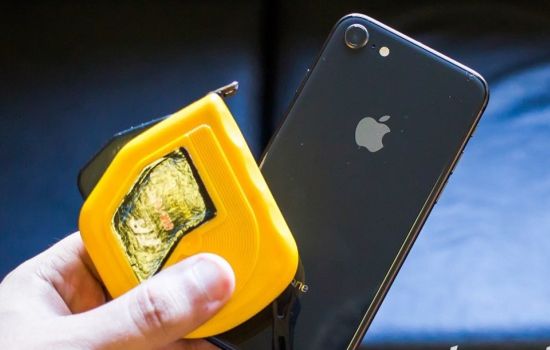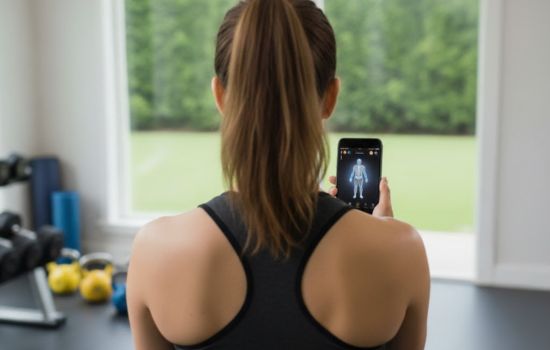Advertisements
Sunday morning. You have two hours to fix that wobbly bookshelf.
You look for the tape measure. It's not where it should be.
You check the kitchen. The garage. The “stuff we don’t know where it goes” drawer.
Nothing.
Advertisements
Forty-five minutes later you find a 30cm ruler that clearly isn't going to measure an entire wall.
Advertisements
Your project becomes procrastination.
And so, Sunday after Sunday, that shelf keeps wobbling.
How many projects have you abandoned for this exact reason?
We all know that frustration.
The good news: It's over forever.
See also
- The Final Verdict on Your IQ, on Your Smartphone
- Don't Miss Out: GPS That Works Without Internet
- Enjoy your favorite stories without touching your wallet
- Detects metals and gold in seconds
- Reveal your celebrity clone in seconds
The paradox of availability
We carry supercomputers, but we look for rules
Your smartphone has more processing power than the computers that sent Apollo 11 to the moon.
It can identify your face among millions, translate 100 languages instantly, and navigate any city in the world.
But when you need to measure 50 centimeters, you run around the house looking for a plastic ruler.
The disconnection was absurd.
Until some developers asked the obvious question:
Why continue to rely on physical objects when we already have everything we need at our fingertips?
Ruler App: The answer you've been waiting for
Ruler App was born out of a universal frustration.
Its creator was a graphic designer. He constantly measured elements on the screen. His physical rulers were never where he needed them.
One day he had an epiphany: “My screen has exact dimensions. My phone knows those dimensions. Why not make the screen the ruler?”
The beauty of the obvious
Automatic calibration: The app knows the exact specifications of your smartphone model.
Consistent accuracy: No wear, no deformation, no manufacturing errors.
Absolute availability: As long as you have your phone, you have your period.
Unexpected versatility: Horizontal, vertical, diagonal, at any angle.
Cases where Ruler App changed the game:
Design and creativity: Artists measuring materials, proportions, and workspaces without interrupting the creative flow.
Practical education: Teachers teaching math with tangible examples that all students can replicate.
Smart Shopping: Check the dimensions of small products before purchasing online or in physical stores.
Home repairs: Measure screws, wires, pipes, and components without searching for tools all over the house.
The solution was in the sensors
Moasure Turn your smartphone into a personal inertial navigation system.
Accelerometers They track every movement with millimeter precision.
Gyroscopes detect rotations and changes in direction.
Sensory fusion algorithms combine multiple data for exact calculations.
Smart calibration adapts to your specific way of walking and moving.
Revolutionizing impossible measurements:
Farmers calculating plot perimeters by walking the boundaries with your phone.
Architects measuring existing buildings without scaffolding or specialized equipment.
Athletes calculating training distances on varied terrain.
Owners determining exact areas of gardens, patios, and outdoor spaces.
Students conducting physics experiments that previously required equipped laboratories.
EasyMeasure: Augmented reality that works
EasyMeasure approached the problem from a completely different angle.
What if we could measure distant objects by pointing the camera at them?
What if complex trigonometry became as simple as taking a photo?
Mathematical magic simplified
Simple entry: Your height, the tilt of your phone, and what you see on the screen.
Complex processing: Advanced trigonometric calculations performed instantly.
Immediate result: Exact distances and heights without getting close to the object.
Applications that no one had imagined:
Workplace safety: Workers measuring dangerous structures from a safe distance.
Real estate appraisals: Appraisers calculating property dimensions without physical access.
Professional photography: Photographers determining optimal distances for composition and lighting.
Scientific research: Biologists measuring specimens in natural habitats without interfering.
Urban planning: Urban planners calculating public spaces from strategic observation points.
The psychology of tool change
Why we resist the obviously best
Familiarity bias: “I’ve always done it this way” feels more secure than “there’s a better way.”
Emotional investment: We have spent money on physical tools and justify their continued use.
Fear of error: We fear that technology will fail us at critical moments.
Social pressure: “Real professionals use real tools” (obsolete concept).
How to overcome mental resistance
Risk-free experimentation: Use apps as a complement, not an immediate replacement.
Cross-checking: Compare results with traditional tools until you gain confidence.
Gradual adoption: Start with non-critical measurements and gradually increase reliance.
Share experiences: Talk to other users who have successfully made the transition.
Transformative case studies
Ana, garden designer:
“I used to have to visit properties twice: once to view, once to measure. With Moasure, I can walk the perimeter while talking to clients, calculate areas instantly, and submit proposals the same day. My productivity has tripled.”
Carlos, math teacher:
“EasyMeasure revolutionized my trigonometry classes. Students measure the height of the school building, calculate distances to the soccer field, and understand abstract concepts because they apply them in their real-life environment. Average grades increased by 401p3t.”
Marta, moving entrepreneur:
“Ruler App changed my moving business. I can provide accurate quotes over video calls, measuring furniture with the customer in real time. I reduced preliminary visits by 80% and increased conversions by 60%.”
Luis, engineering student:
“My thesis project required field measurements that I couldn't afford with professional equipment. The three apps allowed me to collect accurate data on a student budget. My research was published in a specialized journal.”
The industries that have already changed completely
STEM Education
Science, technology, engineering, and mathematics teachers have massively adopted these tools.
Result: Students learn abstract concepts with instant practical applications.
Residential real estate
Real estate agents use mobile surveying to provide accurate information without specialized equipment.
Result: Faster sales processes and more informed customers.
Independent interior design
Freelance designers compete with large studios using affordable tools.
Result: Democratization of professional design.
Technical education
Trade schools teach digital measurement as a basic skill.
Result: More versatile and employable graduates.
Emerging trends that will accelerate adoption
Integration with artificial intelligence
Apps that learn usage patterns and suggest metrics before you ask for them.
Persistent augmented reality
Measurements that remain visible on the physical environment throughout the project.
Real-time remote collaboration
Distributed teams measuring and planning spaces simultaneously.
Automation of derivative calculations
Basic measurements that automatically generate calculations of materials, costs, and time.
Blockchain of certified measurements
Immutable records of measurements for legal and contractual applications.
The critical moment of adoption
We are in the perfect window of opportunity
The technology has already matured: Initial errors have been corrected, accuracy is reliable.
Costs were minimized: Free or low-cost apps outperform expensive tools.
Adoption accelerated: Millions of users validated its practical effectiveness.
Resistance weakens: Every day more professionals and casual users are making the switch.
Why waiting is costly
Learning curve: The sooner you start, the sooner you master the tools.
Competitive advantage: In competitive markets, efficiency makes the difference.
Opportunity cost: Every slow project is a missed opportunity.
Cultural adaptation: Market expectations are already changing.
The experiment that will convince you
7-Day Challenge
Days 1-3: Use only traditional tools for all your measurement projects.
Days 4-6: Use only Ruler App, Moasure, and EasyMeasure for similar projects.
Day 7: Compare productivity, accuracy, and frustration level.
Metrics to watch:
- Total time spent on measurement
- Number of projects completed vs. started
- Measurement accuracy (subsequently verified)
- Stress level during the process
- Ease of sharing results with others
Prediction: The difference will be so obvious that you'll never go back to the old ways.

Conclusion
Thousands of people have already freed themselves from the tyranny of lost tools.
Ruler App, Moasure, and EasyMeasure They are not just applications.
They are tools of liberation.
The question isn't whether these apps will replace traditional tools in your life.
The question is when will you stop being held hostage by physical objects that limit your productivity.
Every day you spend searching for lost tools is a day you could have spent completing projects.
Your liberation is just a click away.
When are you going to claim it?




